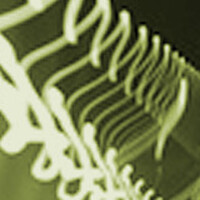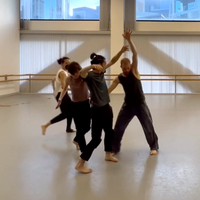Urban experience, affect and the choreographic aesthetic
Blog post
By Lise Uytterhoeven
At one moment, dancers kneel and perform a series of gestures in unison, leaning forward onto their fists, collapsing their elbow, circling their hands around their face reminiscent of waacking, and bending their hands and fingers in angular shapes similar to the street dance style finger tutting. In another moment, the dancers luxuriate in a balletic developpé à la seconde. In yet another, they shift their weight in a wide stance with their knees bent deep, tracing a movement pattern I encountered a long time ago in my Kung Fu martial arts practice. To clarify the contrasting dynamic qualities and accents in this eclectic composition of divergent movement styles, Yukiko Masui coaches the dancers to find their different characters and backstories in each movement. ‘Be cute,’ she says in relation to one movement. ‘Indulge like a ballerina,’ she says about another. ‘Hug the space and feel the groove,’ she says somewhere else. With every change of movement, a different personality comes out. The composition is fragmented and at times almost seems randomized, hard to predict and taking the spectator on a rollercoaster ride.
I step out of the airconditioned marble lobby of the Harbourview Hotel, stepping into the humid heat of the street. I make my way up the stairs of the footbridge and elevated walkway across Gloucester Road, crossing a stream of pedestrians to make my way onto the right side of the walkway, slipping into the flow of people walking. At street level, surrounded by high rise buildings on all sides, the familiar logo of M&S beckons me and across the road the familiar colourful stripes of 7/11. Do I want to eat sushi, tacos or Chinese food? I walk past the big open windows of a pub where people are watching a rugby match. I am charmed by the cute, old-fashioned pink, purple and blue tram carriages passing me in the middle of the road.
The urban movement practices of Hip Hop, Ballroom and Latin, in which Masui originally trained in Tokyo, have been further shaped by London’s contemporary urban dance landscape, and are now fed back into the busy environment of Hong Kong as a megacity, bringing a degree of sensory overwhelm. Everyone living in or visiting Hong Kong has to navigate this urban bodily reality. The specificity emerging from the affects of being in this particular city, working with these particular dancers, is palpable in Masui’s process and in the work she is creating. What is this relationship between creative process and place? How does the affect of the urban experience influence the choreographic aesthetic?
The dancers stand in a circle, facing inwards. One by one, they walk the diameter of the circle through the middle in eight paces, before making a sharp 180 degree turn and going back the other way. Masui reminds them to keep the line pattern sharp and to never curve the edges. The dancers walk in a canon of 1 musical count, creating a cycloid – a rolling circle – through their walking pattern, reminding me of the spirograph toy with which I used to play as a child, drawing intricate shifting circular patterns on paper. ‘Don’t think about trying to keep the circle; it happens anyway,’ Masui says. ‘You’re not following anyone. Follow your own path.’ If one person delays their passing through the centre, it affects the whole thing. This difficult choreographic proposition needed some practice, but after a while, the dancers nailed it!

Next, music by Kenichi Kasamatsu, a Japanese dancer who works in New York, tunes us into our breath. The voice exaggerates breath and vocalizes a range of random consonants, making for a non-verbal auditory landscape. In rehearsal, Masui sings the vocalizations from her iPad, where she has transcribed the sounds in Japanese characters. A whole new language has been developed to refer to the dynamic qualities of the movements: ‘Hee-hoo-hee-hoo, fun-tch-tch-tch, hun-tch-tch-tch, kch-kch-kch, tzuh-tzuh-tzuh, hooh-hooh-hooh, ah-ah-ah.’ I had encountered dance artists using vocalization before in classes or in rehearsals to clarify qualities and inspire dancers, but not to the extent to which Masui is using it. The fact that these non-verbal vocalizations also become a kind of makeshift movement notation system is astounding.
Each choreographed movement corresponds to a vocal sound in Kasamatsu’s music. This kind of music visualization is referred to by the British choreomusicological scholar Stephanie Jordan as Mickey-Mousing. Typically, choreographers resist this kind of precise synchronization of movements to music, which is sometimes even referred to as ‘musical tyranny’. In this particular choreography, though, the term Mickey-Mousing draws attention to the cartoon-like quality of Masui’s choreography, which shares some qualities with animation through its aesthetic emphasis on eclecticism, fragmentation and randomisation.
The choreographic creation and navigation of tight spaces, with narrow misses and dancers brushing past each other, are combined with movements that focus us in on the breath. All these aesthetic choices draw me into reflections on the relationships between the urban space of Hong Kong, the affects I experience as a visitor in this city and as a spectator of this work, and influence how I am reading the choreographic aesthetic of the work.
Posted by

Andrew Lang

